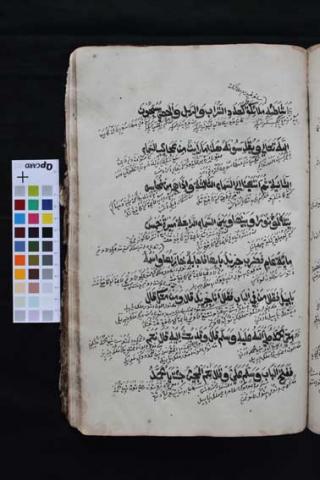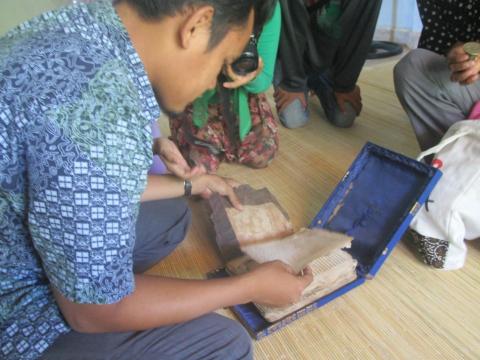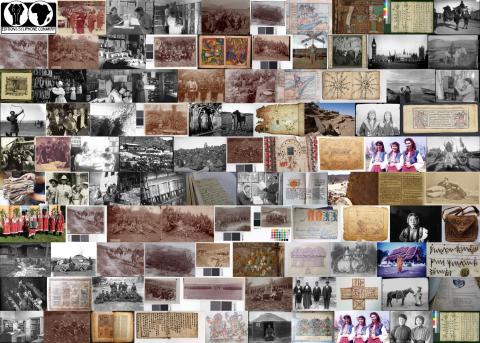
Aims and objectives
This pilot project aims to discover and evaluate collections of lontara’ manuscripts in the Makassarese language of South Sulawesi, Indonesia. Lontara’, written on paper in either of two indigenous syllabaries, can date back to the 17th century. Although the best-preserved examples are found in European libraries and museums, there still exist numerous privately owned lontara’ in South Sulawesi, where they often have the status of heirlooms or ceremonial objects. Although some projects in previous decades have photographed lontara’, it is certain that important collections were missed, potentially in large enough numbers to justify a major project.
This project will result in a written report on the state of lontara’ collections remaining in South Sulawesi, and (where possible) in digital copies of representative samples from the collections. A survey will also be made of the Makassarese lontara’ in the microfilmed collections held at the Indonesian National Archive (ANRI), with an evaluation of the adequacy of the images. If there are indeed substantial collections of unrecorded Makassarese lontara’ extant in South Sulawesi, these collections will form the basis of a comprehensive project to (a) endeavour to protect them, and (b) digitally photograph them in situ for archiving. It is hoped that these could ultimately be included in a comprehensive annotated digital archive of Makassarese lontara’, also containing images from lontara’ in Western collections made through separately funded projects.
Lontara’ manuscripts from Makassar in South Sulawesi is a writing tradition of moderate age, with the oldest known manuscripts dating from the late 17th century. The manuscripts, written on paper in either of two indigenous syllabaries, consist largely of chronicles or histories of local kingdoms, collections of rules relating to customary law, or court diaries/daybooks. They are thus invaluable in telling us about local histories and customs from the pre-colonial and pre-industrial periods. The Makassarese tradition differs from the better-known lontara’ tradition of the Bugis people (also from South Sulawesi) which largely revolves around epic legendary tales known collectively as I La Galigo. While many of the oldest existing Makassarese manuscripts are in Western museums or libraries (mostly in the Netherlands or Germany) and can be considered ‘safe’ (though not necessarily easy to access, especially for the Makassarese people themselves), many others remain in local collections and are subject to various threats: from the humid climate, from inadequate curation, and from continued ritual use. This last point is crucial: some lontara’ are considered sacred ceremonial objects to be brought out on special occasions and handled, and in some cases exposed to smoke or sprinkled with liquid. While it is encouraging to see ceremonies like this remain part of cultural life, they are undeniably hazardous to the manuscripts.
There are certainly collections still in South Sulawesi that have not yet been microfilmed. One important collection is that of the former royal palace of Sungguminasa near Makassar, where some lontara’ are still in ritual use. Other private collections, usually in the houses of former nobility or provincial royalty, were kept secret due to a combination of superstition and distrust of officialdom during the Suharto era, but with a change in the political climate and a new generation of custodians they may now be made available for photographing. The Principal Investigator is in a good position to negotiate for this, having good connections in the region, can speak Makassarese, and is one of the few people in the world who can read the old Makassarese script as well as the more common Bugis script – some of the owners of heirloom lontara’ in South Sulawesi cannot read them and have little or no idea of their contents.
The images and associated metadata will be deposited at ANRI and the National Library in Jakarta, the regional library in Makassar, and the British Library. The general aim will be to discover whether sufficient collections of lontara’ remain, and whether permissions will be forthcoming, to justify a future major project.
Outcomes
The project was able to confirm that there were substantial collections of unrecorded lontara', especially in villages outside the urban area of Makassar. Some owners were not willing to allow all of them to be photographed (or may demand payment and/or animal sacrifice before opening them), but others were happy to allow at least certain genres to be photographed and digitally archived. The project was able to make representative images from several lontara' in Makassar, and in a number of villages in Kecamatan Galesong south of the city. Images from the pilot project have been deposited with the South Sulawesi Regional Library and Archive, and with the British Library. Equipment used for the project was deposited with the South Sulawesi Regional Library and Archive to be used for ongoing digitisation work.
The records copied by this project have been catalogued as:
- EAP365/1 Collection of Jamaluddin Aziz Paramma Daeng Jaga, Makassar, South Sulawesi, Indonesia [1957-1970s]
- EAP365/2 Collection of Daeng Jarung, Desa Boddia, Galesong, South Sulawesi, Indonesia [1975]
- EAP365/3 Collection of Daeng Tiro, Desa Boddia, Galesong, South Sulawesi, Indonesia [1920s]
Due to the cyber-attack on the British Library in October 2023, the archives and manuscripts database is currently inaccessible and we are unable to provide links to the catalogue records for this project.
Survey report (PDF document 2750 KB)





